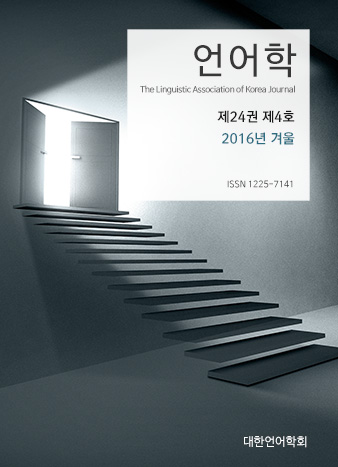대한언어학회 전자저널

-
An Alternative Approach to Realizations of the Medial [nt] Cluster in English
-
Boundary and pitch effects on the perception of Korean alveolar nasal
-
Corpus-Based English Grammar Instruction in a Korean College Context Korean College Context
-
A Study on the Relationship between Self-Efficacy Beliefs and Comprehension in English Reading
Abstract
Keywords
# 합성어(compound) # 규칙 복수명사(regular plural) # 이질성(heterogeneity) # 중의성(ambiguity) # 유형(type) # 개체(token)
References
- Alegre, M. A., & Gordon, P. (1996). Red rats eater exposes recursion in children's word formation. Cognition, 60, 65–82.
- Alegre, M. A., & Gordon, P. (1999). Why compounds researchers aren't rats eaters: Semantic constraints on regular plurals inside compounds. Unpublished manuscript, Teachers College, Columbia University.
- Berent, I., & Pinker, S. (2007). The dislike of regular plurals in compounds: phonological familiarity or morphological constraint? The Mental Lexicon, 2, 129-181.
- Di Sciullo, A. M., & Williams, E. (1987). On the definition of word. Cambridge, MA: MIT Press.
- Gordon, P. (1985). Level-ordering in lexical development. Cognition, 21, 73–93.
- Haskell, T. R., MacDonald, M. C., & Seidenberg, M. S. (2003). Language learning and innateness: Some implications of Compounds Research. Cognitive Psychology, 47, 119–163.
- Johansson, S. (1980). Plural attributive nouns in present-day English. Lund: CWK Gleerup.
- Kiparsky, P. (1982). From cyclic phonology to lexical phonology. In H. van der Hulst & N. Smith (Eds.), The structure of phonological representations (part 1). Dordrecht, The Netherlands: Foris.
- Lieber, R., & Šekauer, P. (Eds.). (2009). The Oxford handbook of compounding. Oxford: Oxford University Press.
- Pinker, S. (1999). Words and rules: The ingredients of language. New York: Harper Perennial.
- Quirk, R., Greenbaum, S., Leech, G., & Svartvik, J. (1985). A comprehensive grammar of the English language. London: Longman.
- Selkirk, E. O. (1982). The syntax of words. Cambridge, MA: MIT Press.
- Senghas, A., Kim, J. J., & Pinker, S. (2007). Plurals-inside compounds: morphological constraints and their implications. Barnard college.
- Spencer, A. (1991). Morphological theory: An introduction to word structure in generative grammar. Cambridge, MA: Blackwell.
- Sproat, R. (1985). On deriving the lexicon. Bloomington: MIT.
- Warren, B. (1993). Nominal and adjectival modifiers of nouns. In Andreas H. Jucker (Ed.), The noun phrase in English. Its structure and variability. Anglistik and Englischunterricht, 49 (pp. 57-68). Heidelberg: Winter.